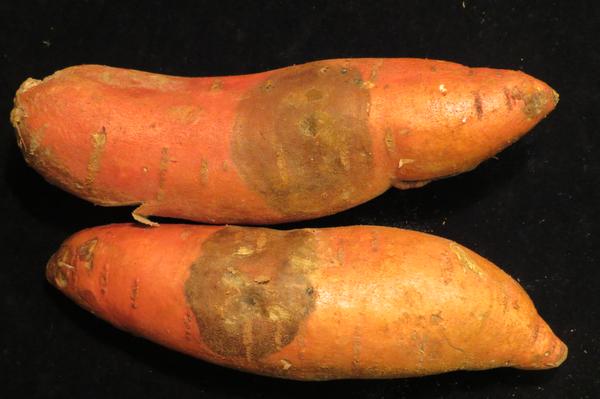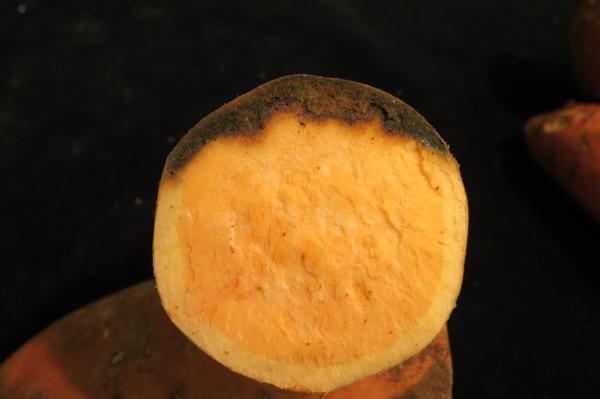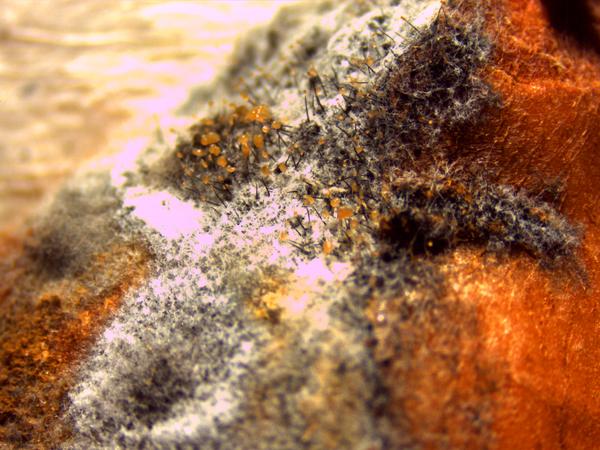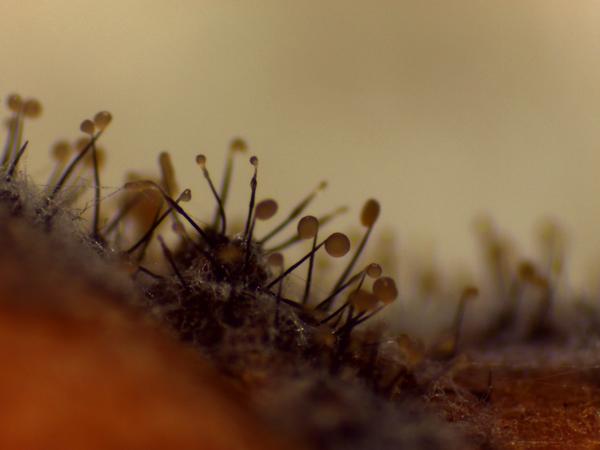Pathogen
Black rot of sweetpotato is caused by the ascomycete fungus Ceratocystis fimbriata.
Host Crops and Plants
C. fimbriata can infect several woody plants such as fig, cacao, mango, coffee and eucalyptus. For a complete host list please visit the USDA Fungus-Host Distributions Database. However, it is believed that isolates of C. fimbriata are mostly host specific, thus, in the case of isolates infecting sweetpotato (Ipomoea batatas), isolates infecting morning glory (Ipomoea spp.) constitute the most likely source of inoculum.
Identification
Symptoms generally are seen at harvest, after curing or after storage and consist of a dry, firm, dark-colored rot that does not extend into the cortex of the sweetpotato root. Infections typically begin at wounds, lenticels, or lateral roots and can expand in diameter during storage. Examination of infected tissue with a hand lens may reveal the white mycelia and black perithecia of C. fimbriata growing on the lesion surface, which is a key diagnostic feature of black rot. If infected roots are bedded for transplant production, symptoms may also appear on plants in the bed or after planting. Infected slips develop dark, sunken cankers below the soil surface and severe infections can result in the stunting, wilting, and even death of sprouts.
Favorable Environmental Conditions for the Disease
Black rot can occur over a wide range of temperatures and soil moisture levels. Optimal conditions for disease development are:
- Temperatures ranging from 23-27°C in the field.
- Soil moisture levels of -0.1 to -0.2 bars.
- Presprouting of roots at warm temperatures.
Disease Transmission
Black rot is typically transmitted from infected parent material (roots or slips), infested soil, infested equipment, and some insects. Bedding roots that are infected with black rot can result in pathogen transmission to slips and then onto the subsequent sweetpotato roots. C. fimbriata can also survive in the soil for several years or on the roots of wild morning glories due to the formation of overwintering spores called chlamydospores. Infections can also take place on wounded sweetpotatoes during washing and packing if any equipment or wash tank is contaminated with the pathogen. Some insects have also been found to move the sticky ascospores on sporulating black rot lesions that produce a fruity odor and attract insects.
General Disease Management
Prevention is the best method of controlling black rot and several steps can be taken to limit black rot outbreaks:
- Only bed disease free roots for transplant production
- Cut slips a minimum of 4 cm above the soil surface to limit pathogen entry into wounds
- 3-4 year crop rotation
- Avoid planting in fields known to be infested with C. fimbriata
- Remove debris and morning glories that can serve as pathogen reservoirs in fields
- Clean harvesting equipment, crates, water tanks, and packing lines with chlorinated water
- Debris should be removed from bins prior to use. Wood bins can be sanitized by heating at 110°F for a minimum of 24 hours. Plastic bins can be washed with chlorinated water.
Disease Control for Conventional Growers
No fungicides are effective at controlling this disease after black rot has become established but products can be used to protect seed and slips. The active ingredients thiabendazole and difenoconazole have shown good efficacy for controlling black rot. For the latest fungicide recommendations for sweetpotato black rot see the Southeastern US Vegetable Crop Handbook. Fungicide labels are legal documents, always read and follow fungicide labels.
The following are labeled for use on sweetpotato:
| Active ingredient | Example product | Fungicide group | Use |
| Thiabendazole | Mertect 340-F | 1 | Seed root dips, postharvest spray or dip (section 18 label for North Carolina) |
| Azoxystrobin + Difenoconazole | Quadris Top | 11 + 3 | Field ground or aerial application |
In the packinghouse:
- Sanitize storage bins prior to usage to ensure they are pathogen free. Remove debris from bins. Steam or heat treatments at 110°F for 24 hours are the most effective treatments for wooden bins, high pressure chlorinated water can be used for plastic bins
- Dispose of any infected roots before washing to avoid contaminating the dump tank and packing line
- Avoid recirculating water since if the pathogen has entered the dump tank or packing line, spores will also be re-circulated
- Use a labeled fungicide or chlorine products in the dump tank to eliminate any pathogen spores. Soil and organic matter will make fungicides and chlorine products ineffective, roots should be rinsed prior to any treatment for products to be effective. Ensuring complete coverage is also important, dip treatments are typically more effective than spray/mist treatments
- Clean equipment daily by removing debris and using high pressure chlorinated water to eliminate any spores of the pathogen that can infect wounds on uninfected roots
- Control any insect that could be moving spores and remove culls that could serve as inoculum sources promptly
Disease Control for Organic Growers
Currently no OMRI products are listed for control of black rot in seed beds. However black rot has been successfully controlled in the past through the use of proper management practices as listed above.
Disease Control for Home Gardeners
Black rot has been successfully controlled in the past through the use of proper management practices as listed above.
Useful Resources
- The NC State Plant Disease and Insect Clinic provides diagnostics and control recommendations
- The Extension Plant Pathology Portal provides information on crop disease management
- The Southeastern US Vegetable Crop Handbook provides information on vegetable disease management
- The USDA Fungus-Host Distributions Database provides information about reported hosts for fungal and oomycete pathogens
Acknowledgements
This factsheet was prepared by the NC State Vegetable Pathology Lab in 2014.
Publication date: Oct. 24, 2018
Reviewed/Revised: Jan. 9, 2023
Recommendations for the use of agricultural chemicals are included in this publication as a convenience to the reader. The use of brand names and any mention or listing of commercial products or services in this publication does not imply endorsement by NC State University or N.C. A&T State University nor discrimination against similar products or services not mentioned. Individuals who use agricultural chemicals are responsible for ensuring that the intended use complies with current regulations and conforms to the product label. Be sure to obtain current information about usage regulations and examine a current product label before applying any chemical. For assistance, contact your local N.C. Cooperative Extension county center.
N.C. Cooperative Extension prohibits discrimination and harassment regardless of age, color, disability, family and marital status, gender identity, national origin, political beliefs, race, religion, sex (including pregnancy), sexual orientation and veteran status.




